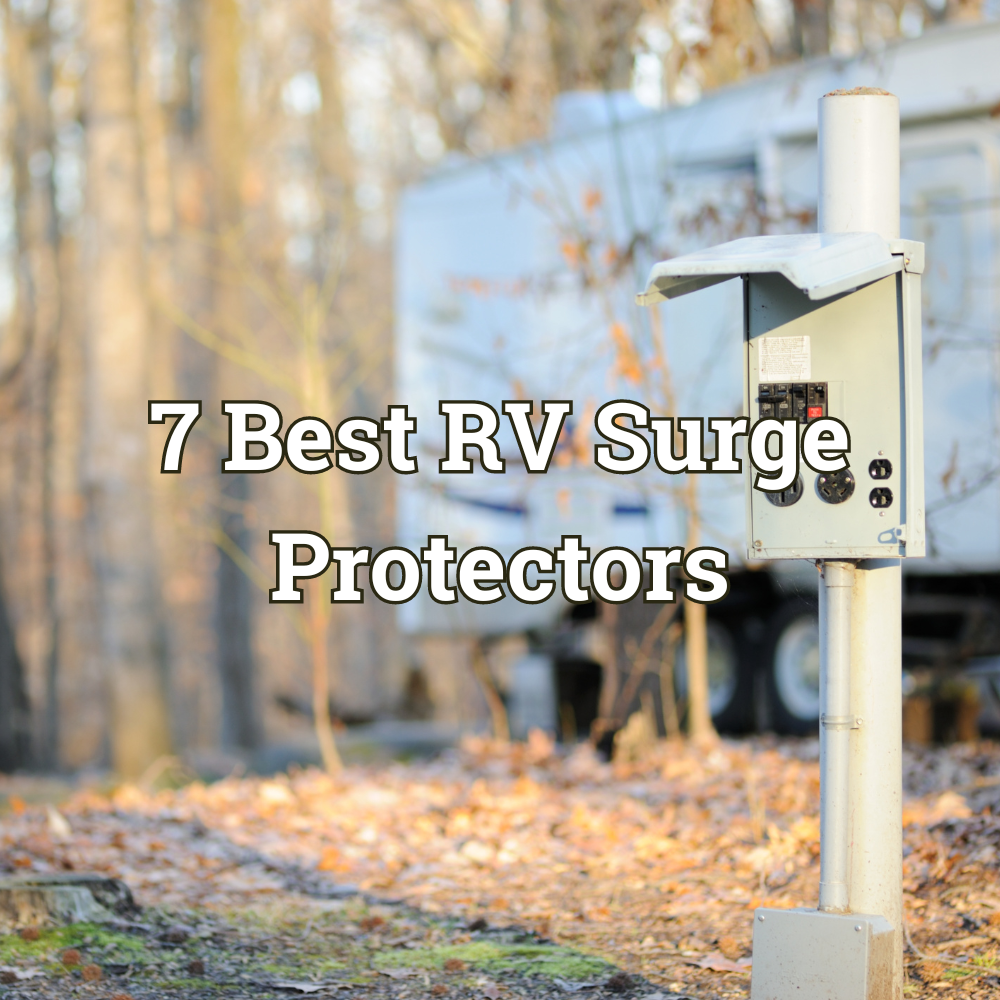
Here we’re going to take a look at some of the best RV tire pressure monitoring systems (RV TPMS for short).
The consequences of not having a tire pressure monitoring system on a large vehicle or travel trailer don’t bear thinking about.
An early warning of a potentially disastrous event is definitely a good idea.
My choice is the TireMinder i10 tire pressure monitoring system.
The recommendations here are put together from my own personal experience and from the experiences of friends and fellow RVers.
Contents
🏆 Best Overall

Best Budget

Here is more of an in depth look at two of the best RV TPMS available, along with a decent budget option.
TireMinder i10 RV TPMS
⭐️Best Overall
TireMinder i10 RV TPMS
The TireMinder i10 tire pressure monitoring system is my pick as the best RV TPMS.
This very popular TPMS comes with a color monitor, 4 tire sensors, 2 sets of batteries for the sensors and a signal repeater. You will also get all the relevant charging cords and a detailed easy to follow owners manual.
Unlike other brands, this system requires the mandatory installation of the included signal repeater. This involves slightly more in the way of set-up, but it will guarantee a very good signal from the sensors (no bad thing). The repeater requires 12 volt power, so you will need to find a suitable power source.
As with most of these units, it’s best to program your tire parameters before you fit the sensors to the vehicle. You can set up to 20 tires on one vehicle, and once set you can then add further settings for another 4 vehicles, which the system will store and remember.
The monitor has excellent battery life, and once charged will last around one week before needing a recharge.
What I really like about the TireMinder i10 is the quality of the hardware, and the reliability of the data signal. The monitor is compact enough to mount virtually anywhere, the manual is clear and easy to follow, and you will also get a 3 year warranty.
Pros
Excellent Build Quality
Good Battery Life
3 Year Warranty
Cons
Expensive Additional Sensors
Overall Rating

Performance / Efficiency

Build Quality

Features / Functions

Reviews

Value For Money

TST 507 Tire Pressure Monitoring System
⭐️Choice #2
The TST 507 is my second pick as an RV tire pressure monitoring system.
This is an upgraded version of the original system and is specially made for RVs, motorhomes and trailers. The system comes with an easy to read color monitor, tire sensors, usb charge cable, dashboard mount, suction mount, signal repeater and instruction manual.
The tire sensors are theft resistant, so you will also get a special fitting/removal tool (don’t forget to keep this tool somewhere in the RV).
The monitor has a rechargeable battery, which after a full charge will last around 8 hours. This is great as you can do a day’s worth of driving without plugging in the usb charge cord. The long battery life also gives you more mounting options as you won’t have to worry about plugging in.
One of the best things about the TST 507 is the auto scrolling function. When looking at the monitor you will see the system scrolling and testing each tire in turn, giving you real time data on a consistent basis.
This is an intelligent system capable of monitoring multiple trailers and vehicles. It will then remember the parameters that you set for each one. When setting the parameters for each sensor it’s much easier to do this off the vehicle when you have all the sensors to hand.
Pros
Auto Scroll Display
3 Year Warranty
Excellent Support
Cons
Display Could Be Better On Bright Days
Overall Rating

Performance / Efficiency

Build Quality

Features / Functions

Reviews

Value For Money

Tymate M12-3 RV TPMS
⭐️Best Budget Option
The Tymate M12-3 is my budget choice as an RV TPMS.
The system includes the monitor, 6 x tire sensors, a signal repeater, a non slip dash mount mat and an owners manual.
Installation is pretty straightforward, you will just need to find some 12 volt power for the signal repeater.
A big plus for this monitor is the fact that it’s solar charged. It will need a full charge from either usb or 12 volt lighter socket first, after that, power can be maintained via the solar panel on the top of the unit. The replaceable sensor batteries will last about 2 years.
The display has an automatic light sensor and will adjust the display backlight to the current light conditions. The display is a little on the small side, but data is easy enough to read.
This system is motion activated, so you will need to be moving before you get any data to the monitor. Important: On first use, the system will need 5-10 minutes before you receive all the tire information to the monitor.
The instruction booklet is basic but easy enough to follow and the unit comes with a 2 year warranty.
Pros
Solar Charge Panel
Auto Sleep Function
6 x Sensors
Cons
Basic Instructions
Display Can Be Confusing At First
Overall Rating

Performance / Efficiency

Build Quality

Features / Functions

Reviews

Value For Money

RV TPMS Installation
All aftermarket tire pressure monitoring systems can have their setup problems.
The most common complaints are:
- Sensor to monitor connection problems.
- Using a TPMS with valve extenders.
TPMS Connection Problems
As a rule, good quality tire pressure monitoring systems have very good range and connection capabilities. But anything that uses wireless technology is going to have issues now and then.
Generally, double checking the sensor batteries and/or a system reset will normally sort out any of these connection problems.
If this doesn’t work, you may find you need a TPMS repeater to strengthen up the signal between the sensor and receiving monitor.
Steel bulkheads and RV wall insulation can all contribute to a weaker signal.
Fitting a repeater/signal booster in between the TPMS sensors and the display monitor will almost always solve any connection issues.
Valve Extenders And Metal Valve Stems
Another issue encountered when retrofitting a TPMS, is fitting the sensors to the original valve stems.
Tires on many smaller RVs will have rubber valve stems, which can cause problems.
You may also find you need a straight or angled extender to get a proper fitment of the sensor.
From talking to other RVers, a few have had problems with adding extenders (especially to rubber valve stems).
To avoid this, I would definitely recommend getting metal valve stems fitted to your tires.
You may find you need to get slightly longer or angled valve stems to properly accommodate the TPMS sensors. A good tire outlet can advise you on this.
If you need an angled or straight extender, and you choose to go this route, using a liquid thread sealer on the threads will definitely help.
Although these issues do happen, it’s important to note that they’re not commonplace.
How Does A TPMS Work?
All tire pressure monitoring systems are relatively simple in how they work.
There are two kinds of systems: Direct and Indirect.
Indirect
An indirect TPMS will use wheel speed sensors to measure wheel speed.
If a tire is underinflated it will spin at a different rate than the other wheels. The sensors will register this and trigger an alert on the dashboard of the vehicle.
Direct
A direct TPMS uses a separate battery operated sensor connected to the tire valve (either internally or externally). The sensor then constantly measures the tire pressure.
If a tire’s pressure is higher or lower than the parameters you set, an alert is sent to a dashboard monitor or phone app.
Direct tire pressure monitoring systems are the systems fitted or retrofitted to RVs.
Types Of TPMS Cap Sensor
There are two types of TPMS cap sensor.
The first is the standard cap sensor which screws onto a valve stem. This is a simple device with a battery. It measures the tire pressure and transmits the data to a dashboard monitor.
The second type is known as a Flow Thru Sensor. This sensor is slightly larger than a standard cap sensor and does the same job. The difference being that you don’t have to remove the sensor to inflate the tire.
What Is the Legal Requirement For RV TPMS?
Because of multiple deaths attributed to under-inflated tires, in the year 2000 the Tread Act was enacted and signed into law by President Clinton.
Effective from the 1st September 2007 in the US, it is a legal requirement for any (new) passenger carrying vehicle under 10,000 lbs in weight to have a tire pressure monitoring system (TPMS).
Despite this, only some new motorhomes have pre-installed TPMS.
It’s not a legal requirement to have TPMS on a travel trailer.
Having a tire pressure monitoring system on your RV I believe is the smart choice.
Considering the size of some RVs and travel trailers, and the serious damage that could come from a tire issue, a good TPMS is definitely a good idea.
My choice would be the TireMinder i10 TPMS.
Please check out my other equipment reviews.
See how we rate products in our reviews here.
FAQ’s
How Long Do TPMS Sensor Batteries Last?
External cap sensor batteries last an average of 2 years.
Internal valve sensor batteries last 5 -10 years.








Hi Rich, Thank you for your nice review on TST’s 507 TPMS kit! Did you know we also have a 770 touch screen display that makes programming sensors even easier? Check out this how-to video: https://youtu.be/DXyiE3tRTmg?si=Y9FHqKiGDWXMq9OX on YouTube (TST 770 Learning Series: Programming Sensors).
All of our TPMS systems come standard with a repeater/signal booster to assure sensors communicate consistently. More info can be found on our website.